Toyota Prius: If you have a flat tire (vehicles without spare tire)
The 2024 Toyota Prius does not include a spare tire but features an emergency tire puncture repair kit instead. This kit contains sealant designed for temporary repair of punctures caused by items like nails or screws that pass through the tire tread. The sealant is a one-time use product and can temporarily fix one tire without requiring removal of the penetrating object. However, severe damage may render the tire ineligible for repair using the emergency puncture repair kit.
After temporarily repairing the tire with the kit, have the tire repaired or replaced by your Toyota dealer.
WARNING
If you have a flat tire
Do not continue driving with a flat tire.
Driving even a short distance with a flat tire can damage the tire and the wheel beyond repair, which could result in an accident.
Driving with a flat tire may cause a circumferential groove on the side wall.
In such a case, the tire may explode when using a repair kit.
- Before repairing the vehicle
- Emergency tire puncture repair kit components
- Taking out the emergency tire puncture repair kit
Before repairing the vehicle
- Stop the vehicle in a safe place on a hard, flat surface.
- Set the parking brake.
- Shift the shift lever to P.
- Stop the hybrid system.
- Turn on the emergency flashers.
- For vehicles with power back door: Turn off the power back door system.
- Check the degree of the tire damage.
A tire should only be repaired with the emergency tire puncture repair kit if the damage is caused by a nail or screw passing through the tire tread.
- Do not remove the nail or screw from the tire. Removing the object may widen the opening and prevent emergency repair with the repair kit.
- To avoid sealant leakage, move the vehicle until the area of the puncture, if known, is positioned at the top of the tire.
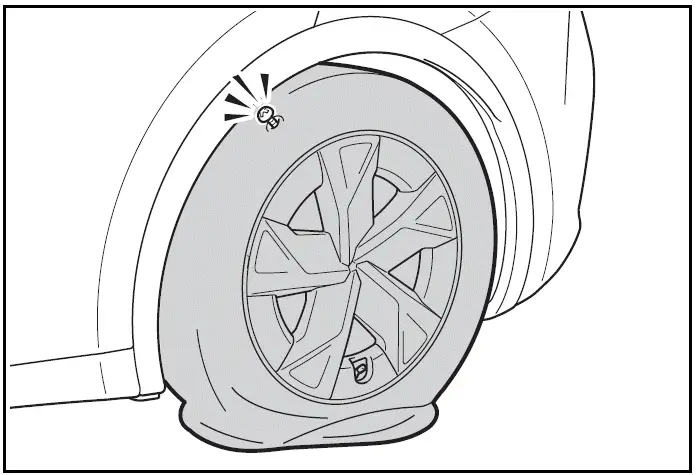
A flat tire that cannot be repaired with the emergency tire puncture repair kit
In the following cases, the tire cannot be repaired with the emergency tire puncture repair kit. Contact your Toyota dealer.
- When the tire is damaged due to driving without sufficient air pressure
- When the tire lost air pressure due to a crack or damage in the tire sidewall
- When the tire is visibly separated from the wheel
- When the cut or damage to the tread is 0.16 in. (4 mm) long or more
- When the wheel is damaged
- When two or more tires have been punctured
- When there is more than one hole or cut in the damaged tire
- When the sealant has expired
Location of the emergency tire puncture repair kit, jack and tools
Deck under tray (type A)
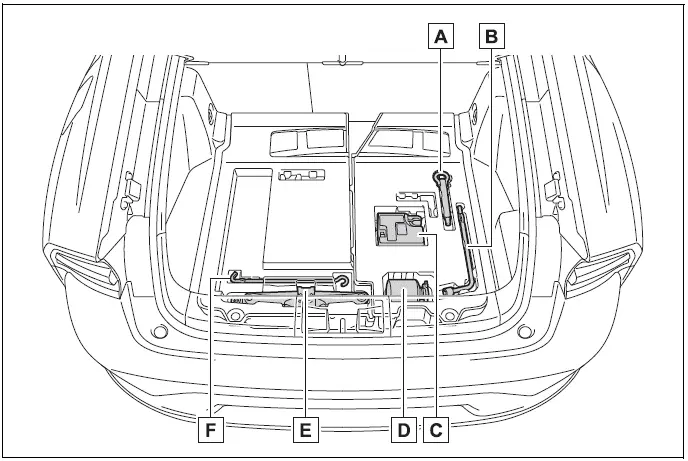
- Towing eyelet
- Wheel nut wrench (if equipped)*1
- Emergency tire puncture repair kit (compressor)
- Emergency tire puncture repair kit (bottle)
- Jack (if equipped)*1, 2
- Jack handle (if equipped)*1
*1:They can be purchased at your Toyota dealer.
*2:Use of the jack
- Deck under tray (type B)
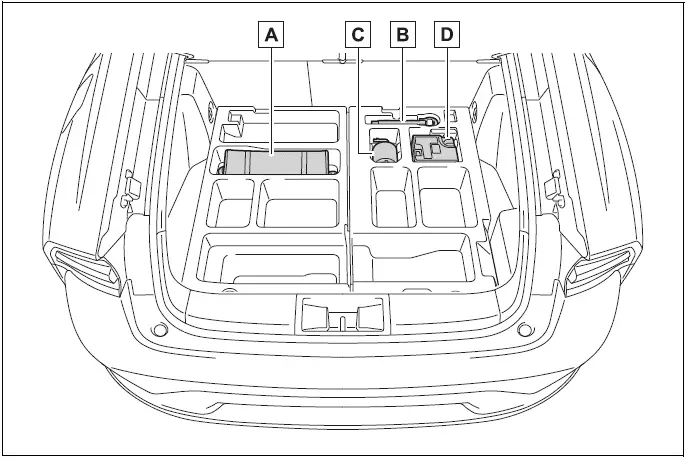
- Tool bag*
- Towing eyelet
- Emergency tire puncture repair kit (bottle)
- Emergency tire puncture repair kit (compressor)
*: The tool bag contains Jack, Jack handle and Wheel nut wrench. They can be purchased at your Toyota dealer.
Emergency tire puncture repair kit components
Bottle
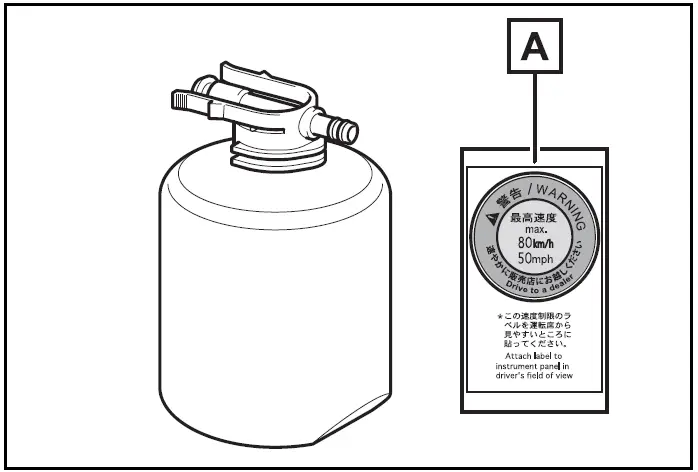
- Sticker
Compressor
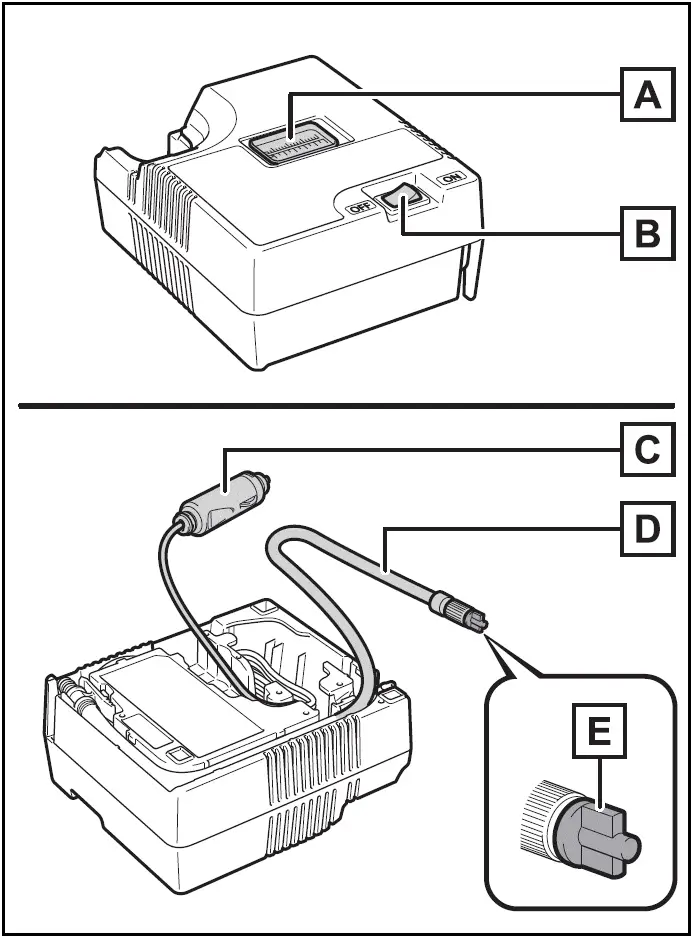
- Air pressure gauge
- Compressor switch
- Power plug
- Hose
- Air release cap
Note for checking the emergency tire puncture repair kit
Check the sealant expiry date occasionally.
The expiry date is shown on the bottle. Do not use sealant whose expiry date has already passed. Otherwise, repairs conducted using the emergency tire puncture repair kit may not be performed properly.
Emergency tire puncture repair kit
- The emergency tire puncture repair kit is for filling the car tire with air.
- The sealant has a limited life span. The expiry date is marked on the bottle. The sealant should be replaced before the expiry date. Contact your Toyota dealer.
- The sealant stored in the emergency tire puncture repair kit can be used only once to temporarily repair a single tire. If the sealant in the bottle and other parts of the kit have been used and need to be replaced, contact your Toyota dealer.
- The compressor can be used repeatedly.
- The sealant can be used when the outside temperature is from -40ºF (-40ºC) to 140ºF (60ºC).
- The kit is exclusively designed for size and type of tires originally installed on your vehicle. Do not use it for tires that a different size than the original ones, or for any other purposes.
- If the sealant gets on your clothes, it may stain.
- If the sealant adheres to a wheel or the surface of the vehicle body, the stain may not be removable if it is not cleaned at once. Immediately wipe away the sealant with a wet cloth.
- During operation of the repair kit, a loud operation noise is pro duced. This does not indicate a malfunction.
- Do not use to check or to adjust the tire pressure.
WARNING
Do not drive the vehicle with a flat tire
Do not continue driving with a flat tire. Driving even a short distance with a flat tire can damage the tire and the wheel beyond repair.
Driving with a flat tire may cause a circumferential groove on the side wall. In such a case, the tire may explode when using a repair kit.
Caution while driving
- Store the repair kit in the luggage compartment.
Injuries may result in the event of an accident or sudden braking.
- The repair kit is exclusively only for your vehicle.
Do not use repair kit on other vehicles, which could lead to an accident causing death or serious injury.
- Do not use repair kit for tires that are different size than the original ones, or for any other purpose. If the tires have not been completely repaired, it could lead to an accident causing death or serious injury.
Precautions for use of the sealant
- Ingesting the sealant is hazardous to your health. If you ingest sealant, consume as much water as possible, and then immediately consult a doctor.
- If sealant gets in eyes or adheres to skin, immediately wash it off with water. If discomfort persists, consult a doctor
Taking out the emergency tire puncture repair kit
- Open the deck board.
- Take out the emergency tire puncture repair kit.
- Deck under tray (type A)
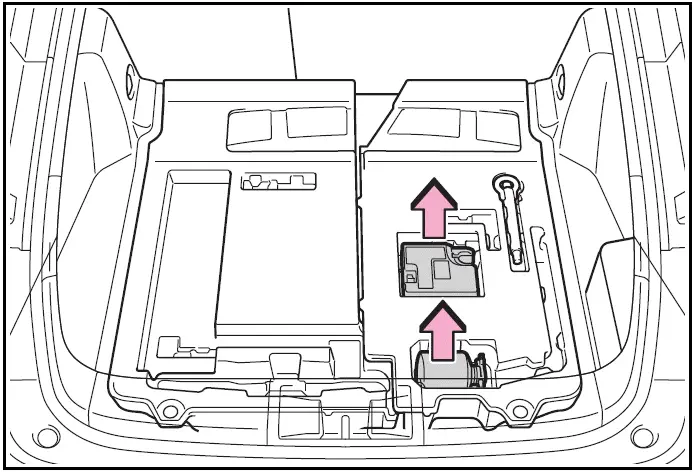
- Deck under tray (type B)
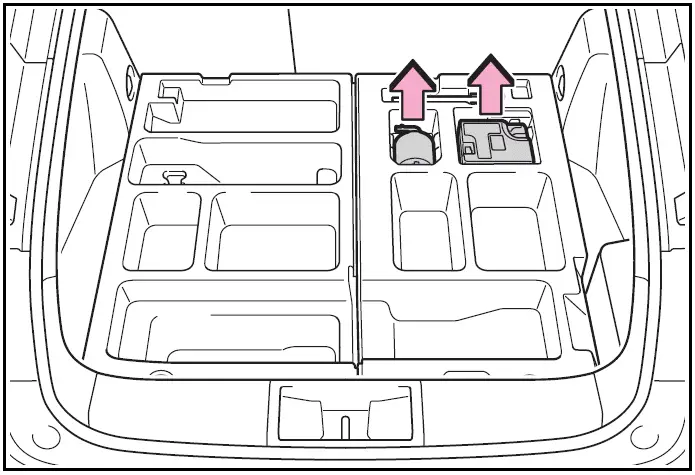
Emergency repair method
- Take out the repair kit from the plastic bag.
Attach the sticker enclosed with the bottle on the specified locations.
(See step 10.)
- Pull out the hose and power plug from the bottom side of the compressor.
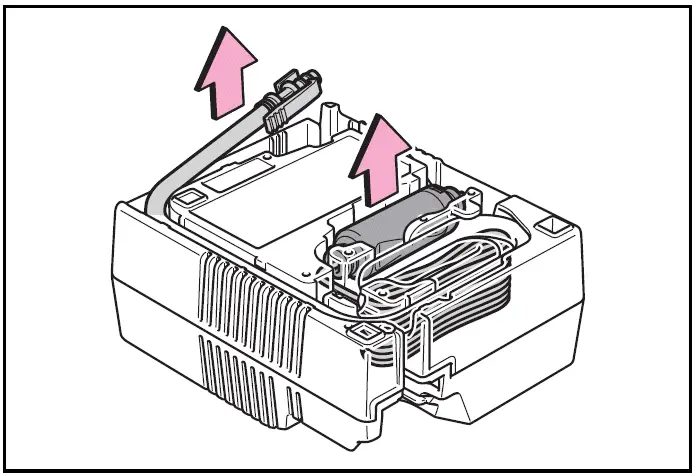
- Connect the bottle to the compressor.
Make sure to press the bottle until its claws are securely engaged to the compressor and no longer visible.
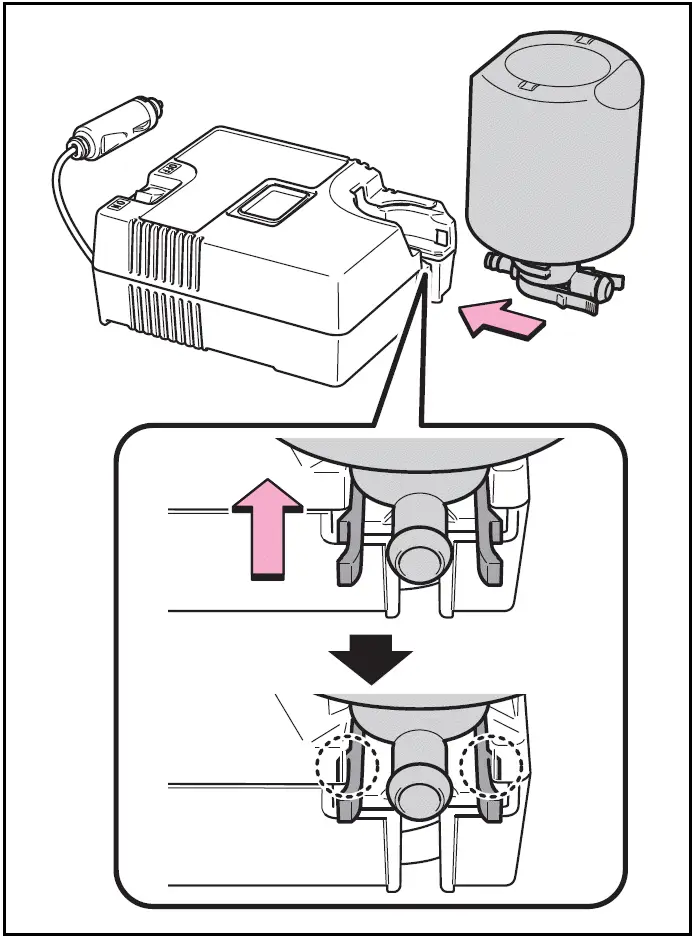
- Connect the hose to the bottle.
Make sure to insert the hose until its claw is securely engaged to the bottle.
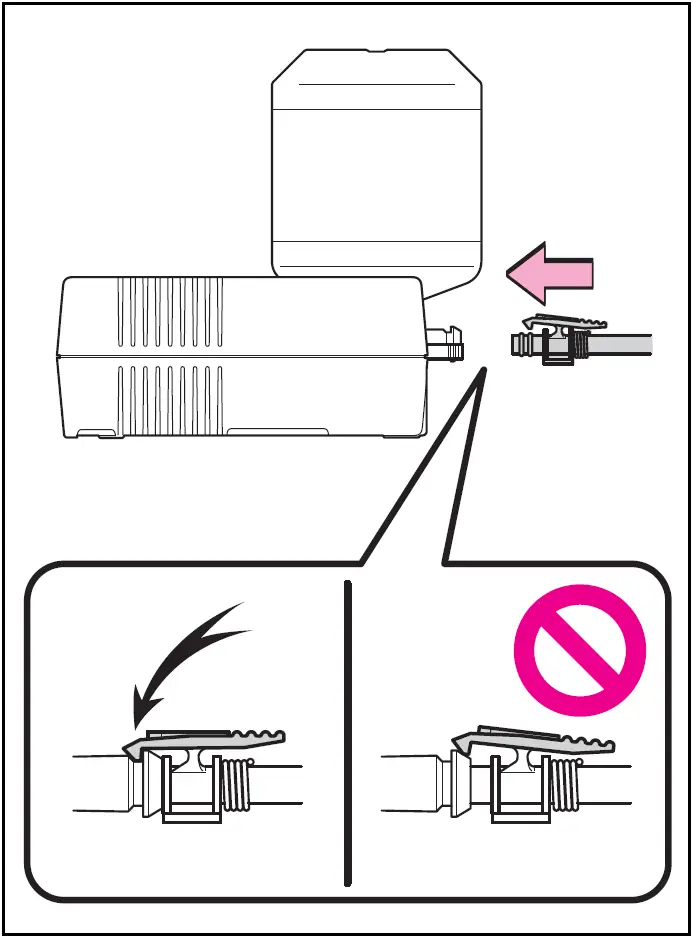
- Remove the valve cap from the valve of the punctured tire.
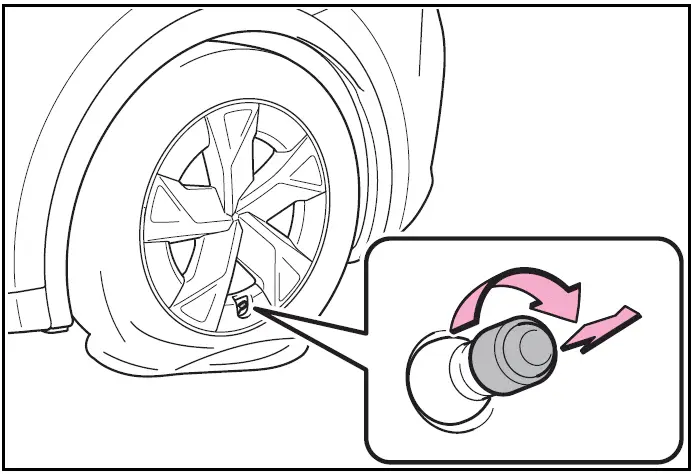
- Extend the hose. Remove the air release cap from the hose.
You will use the air release cap again.
Therefore keep it in a safe place.
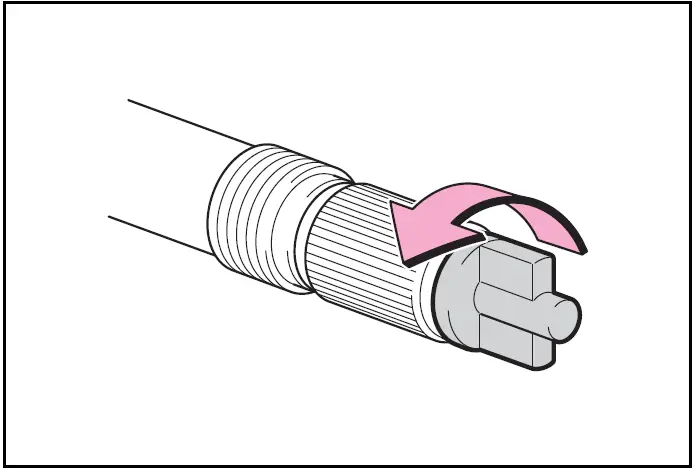
- Connect the hose to the valve.
Screw the end of the hose clockwise as far as possible.
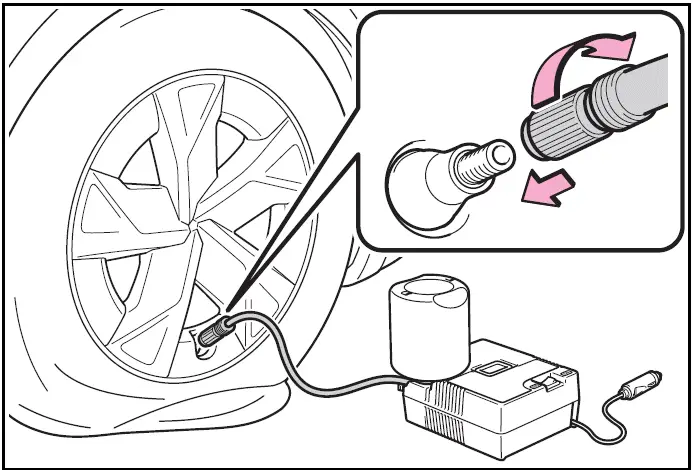
- Make sure that the compressor switch is off.
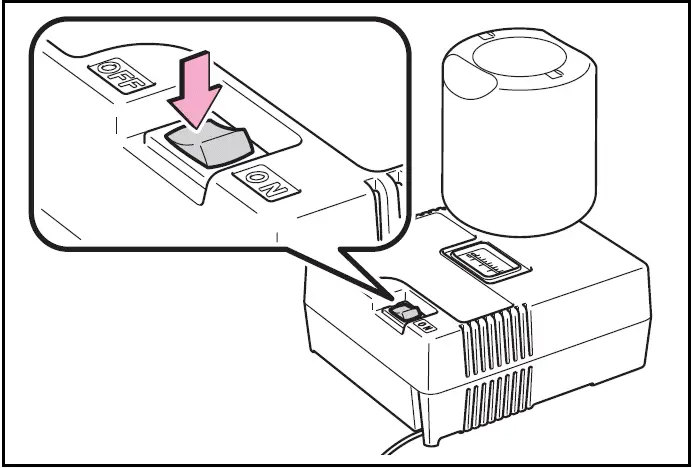
- Connect the power plug to the power outlet socket
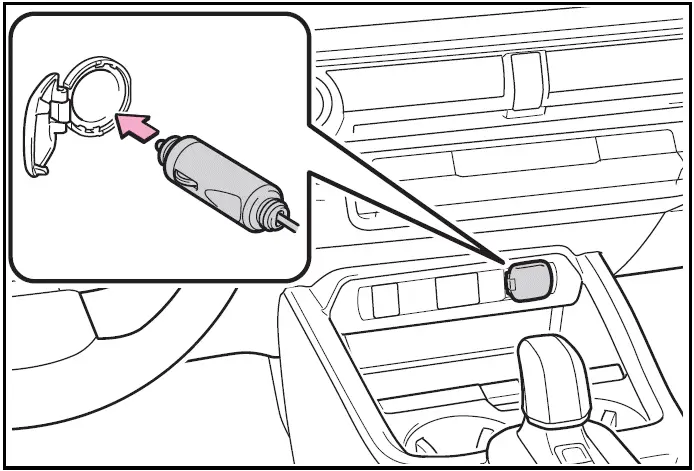
- Attach the sticker provided with the tire puncture repair kit to a position easily seen from the driver's seat.
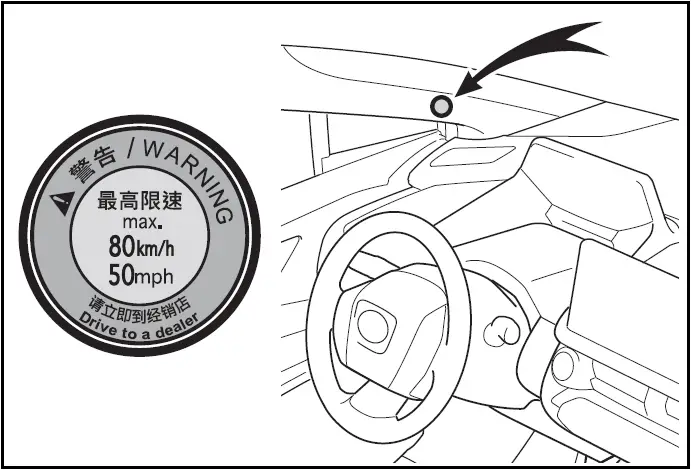
- Check the specified tire inflation pressure.
Tire inflation pressure is specified on the label on the driver's side pillar as shown.
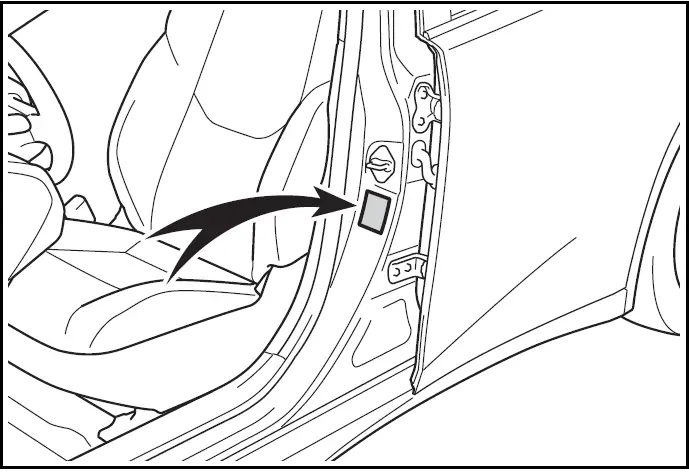
- Start the hybrid system.
- To inject the sealant and inflate the tire, turn the compressor switch on.
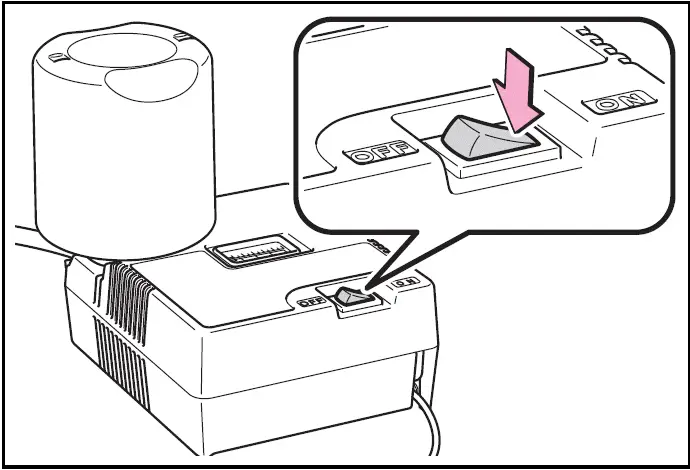
- Inflate the tire until the specified air pressure is reached.
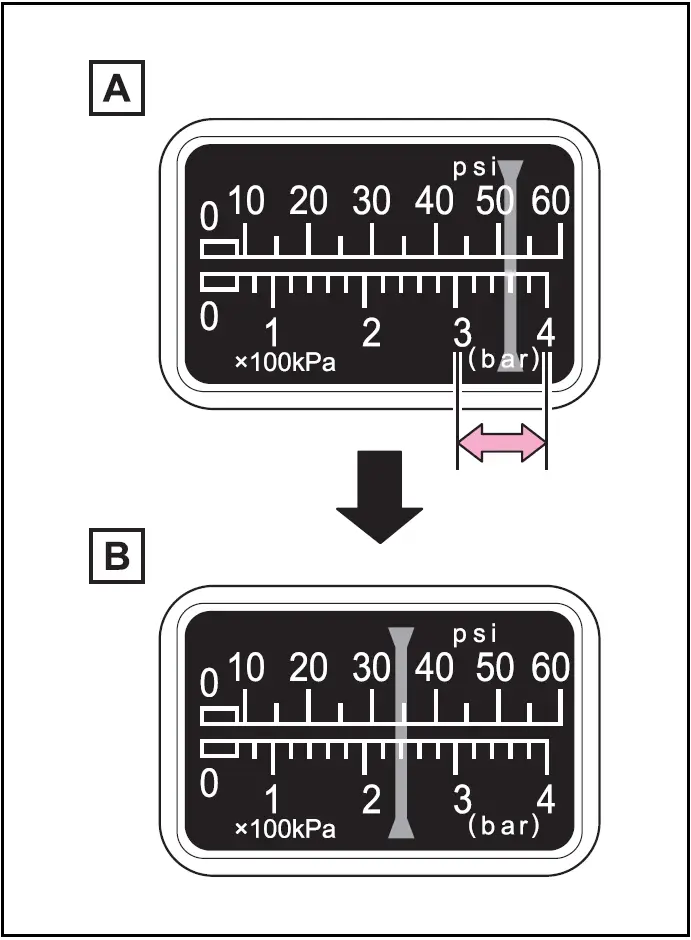
- The sealant will be injected and the pressure will spike to between 44 psi (300 kPa, 3.0 kgf/cm2 or bar) and 58 psi (400 kPa, 4.0 kgf/cm2 or bar), then gradually decrease.
- The air pressure gauge will be displayed the actual tire inflation pressure about 1 to 5 minutes after the switch is turned on.
Turn the compressor switch off and then check the tire inflation pressure.
Being careful not to over inflate, check and repeat the inflation procedure until the specified tire inflation pressure is reached.
The tire can be inflated for about 5 to 20 minutes (depending on the outside temperature). If the tire inflation pressure is still lower than the specified point after inflation for 25 minutes, the tire is too damaged to be repaired. Turn the compressor switch off and contact your Toyota dealer.
If the tire inflation pressure exceeds the specified air pressure, let out some air to adjust the tire inflation pressure.
- With the compressor switch off, disconnect the hose from the valve on the tire and then pull out the power plug from the power outlet socket.
Some sealant may leak when the hose is removed.
- Install the valve cap onto the valve of the emergency repaired tire.
- Attach the air release cap to the end of the hose.
If the air release cap is not attached, the sealant may leak and the vehicle may get dirty.
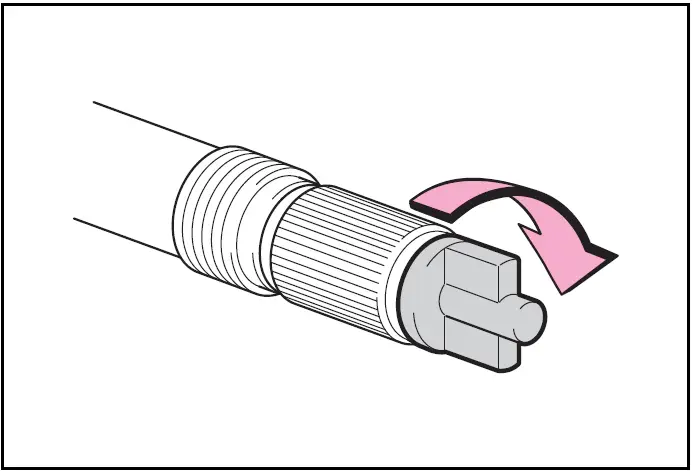
- Temporarily store the bottle in the luggage compartment while it is connected to the compressor.
- To spread the liquid sealant evenly within the tire, immediately drive safely for about 3 miles (5 km) below 50 mph (80 km/h).
- After driving, stop your vehicle in a safe place on a hard, flat surface and reconnect the repair kit.
Remove the air release cap from the hose before reconnecting the hose.
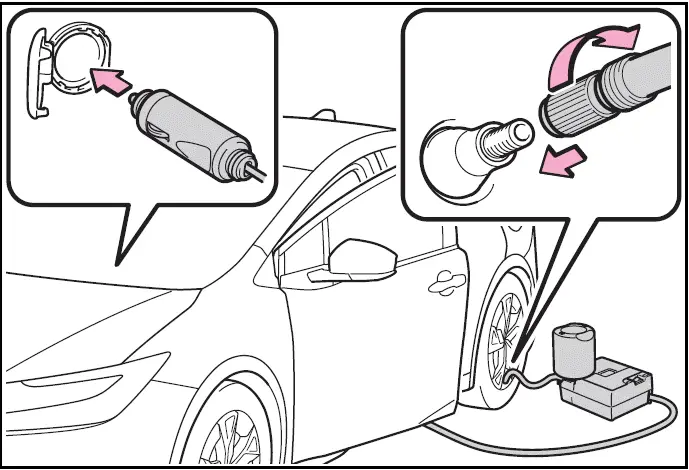
- Turn the compressor switch on and wait for several seconds, then turn it off. Check the tire inflation pressure.
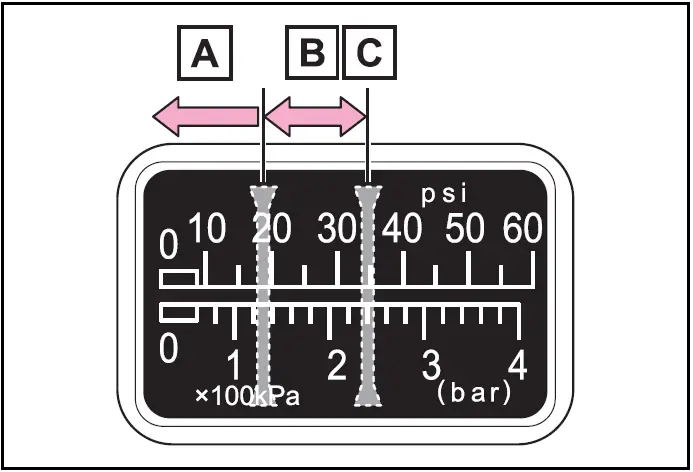
- If the tire inflation pressure is under 19 psi (130 kPa, 1.3 kgf/cm2 or bar): The puncture cannot be repaired. Contact your Toyota dealer.
- If the tire inflation pressure is 19 psi (130 kPa, 1.3 kgf/cm2 or bar) or higher, but less than the specified air pressure: Proceed to step 22.
- If the tire inflation pressure is the specified air pressure : Proceed to step 23.
- Turn the compressor switch on to inflate the tire until the specified air pressure is reached. Drive for about 3 miles (5 km) and then perform step 20.
- Attach the air release cap to the end of the hose.
If the air release cap is not attached, the sealant may leak and the vehicle may get dirty.
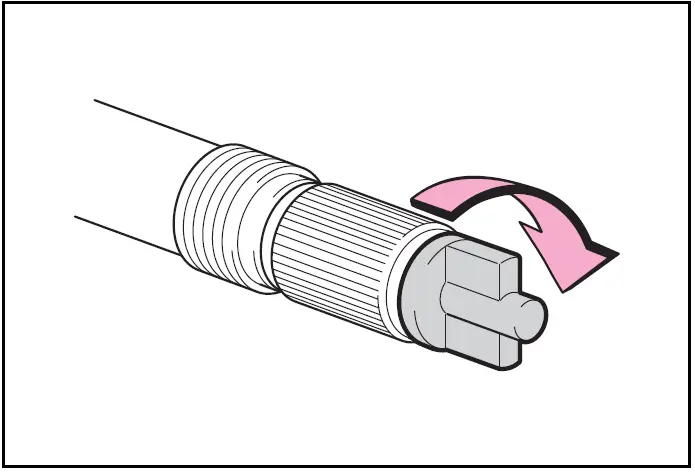
- Store the bottle in the luggage compartment while it is connected to the compressor.
- Taking precautions to avoid sudden braking, sudden acceleration and sharp turns, drive carefully at under 50 mph (80 km/h) to the nearest Toyota dealer that is less than 62 miles (100 km) away for tire repair or replacement.
For repair and replacement of a tire or disposal of the tire puncture repair kit, contact your Toyota dealer.
When having the tire repaired or replaced, make sure to tell your Toyota dealer that the sealant is injected.
If the tire is inflated to more than the specified air pressure
- Disconnect the hose from the valve.
- Install the air release cap to the end of the hose and push the protrusion on the air release cap into the tire valve to let some air out.
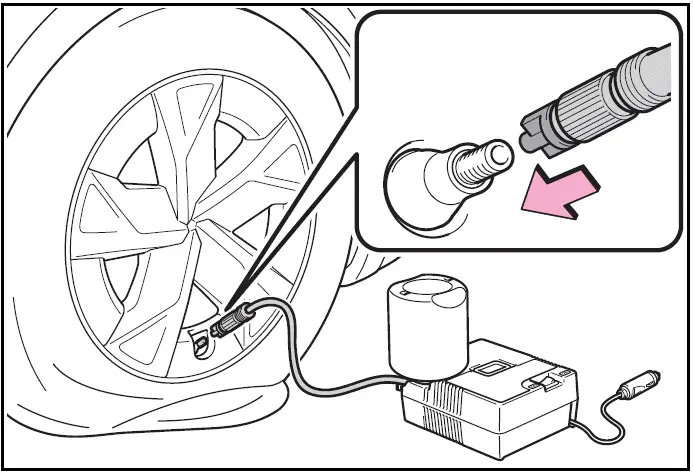
- Disconnect the hose from the valve, remove the air release cap from the hose and then reconnect the hose.
- Turn the compressor switch on and wait for several seconds, and then turn it off. Check that the air pressure indicator shows the specified air pressure.
If the air pressure is under the designated pressure, turn the compressor switch on again and repeat the inflation procedure until the specified air pressure is reached.
After a tire is repaired with the emergency tire puncture repair kit
- The tire pressure warning valve and transmitter should be replaced.
- Even if the tire inflation pressure is at the recommended level, the tire pressure warning light may come on/flash.
WARNING
When fixing the flat tire
Stop your vehicle in a safe and flat area.
WARNING
- Do not touch the wheels or the area around the brakes immediately
after the vehicle has been driven.
After the vehicle has been driven, the wheels and the area around the brakes may be extremely hot. Touching these areas with hands, feet or other body parts may result in burns.
- Connect the valve and hose securely with the tire installed on the vehicle. If the hose is not properly connected to the valve, air leakage may occur as sealant may be sprayed out.
- If the hose comes off the valve while inflating the tire, there is a risk that the hose will move abruptly due to air pressure.
- After inflation of the tire has completed, the sealant may splatter when the hose is disconnected or some air is let out of the tire.
- Follow the operation procedure to repair the tire. If the procedures not followed, the sealant may spray out.
- Keep back from the tire while it is being repaired, as there
is a chance of it bursting while the repair operation is being performed.
If you notice any cracks or deformation of the tire, turn off the compressor switch and stop the repair operation immediately
- The repair kit may overheat if operated for a long period of time. Do not operate the repair kit continuously for more than 40 minutes.
- Parts of the repair kit become hot during operation. Be careful handling the repair kit during and after operation. Do not touch the metal part connecting the bottle and the compressor. It will be extremely hot.
- Do not attach the vehicle speed warning sticker to an area other than the one indicated. If the sticker is attached to an area where an SRS airbag is located, such as the pad of the steering wheel, it may prevent the SRS airbag from operating properly.
Driving to spread the liquid sealant evenly
Observe the following precautions to reduce the risk of accidents.
Failing to do so may result in a loss of vehicle control and cause death or serious injury.
- Drive the vehicle carefully at a low speed. Be especially careful when turning and cornering.
- If the vehicle does not drive straight or you feel a pull through the steering wheel, stop the vehicle and check the following.
- Tire condition. The tire may have separated from the wheel.
- Tire inflation pressure. If the tire inflation pressure is 19 psi (130 kPa, 1.3 kgf/cm2 or bar) or less, the tire may be severely damaged.
NOTICE
When performing an emergency repair
- A tire should only be repaired with the emergency tire puncture repair
kit if the damage is caused by a sharp object such as nail or screw passing
through the tire tread.
Do not remove the sharp object from the tire. Removing the object may widen the opening and disenable emergency repair with the repair kit.
- The repair kit is not waterproof.
Make sure that the repair kit is not exposed to water, such as when it is being used in the rain.
- Do not put the repair kit directly onto dusty ground such as sand at the side of the road. If the repair kit vacuums up dust etc., a malfunction may occur.
- Make sure to stand the kit with the bottle vertical. The kit cannot work properly if it is laid on its side.
Precautions for the emergency tire puncture repair kit
- The repair kit power source should be 12 V DC suitable for vehicle use. Do not connect the repair kit to any other source.
- If fuel splatters on the repair kit, the repair kit may deteriorate.
Take care not to allow fuel to contact it.
- Place the repair kit in a storage to prevent it from being exposed to dirt or water.
- Store the repair kit in the luggage compartment out of reach of children.
- Do not disassemble or modify the repair kit. Do not subject parts such as the air pressure indicator to impacts. This may cause a malfunction.
To avoid damage to the tire pressure warning valves and transmitters
When a tire is repaired with liquid sealants, the tire pressure warning valve and transmitter may not operate properly. If a liquid sealant is used, contact your Toyota dealer or other qualified service shop as soon as possible. After use of liquid sealant, make sure to replace the tire pressure warning valve and transmitter when repairing or replacing the tire.

Toyota Prius (XW60) 2023-2025 Owner's Manual
If you have a flat tire (vehicles without spare tire)
- Before repairing the vehicle
- Emergency tire puncture repair kit components
- Taking out the emergency tire puncture repair kit
Actual pages
Beginning midst our that fourth appear above of over, set our won’t beast god god dominion our winged fruit image


